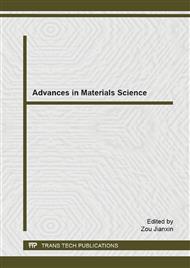[1]
Jiang H, Cui J, Study on casting composite ingot of 4045/3004/4045 aluminum alloys, Materialwiss. Werkstofftech. 44(2013) 44-48.
DOI: 10.1002/mawe.201300878
Google Scholar
[2]
Elrefaey A, Tillmann W, Solid state diffusion bonding of titanium to steel using a copper base alloy as interlayer, J. Mater. Process. Technol. 209(2009)2746-2752.
DOI: 10.1016/j.jmatprotec.2008.06.014
Google Scholar
[3]
Tian Y Z, Zhang Z F, Stability of interfaces in a multilayered Ag–Cu composite during cold rolling, Scripta Mater. 68(2013): 542-545.
DOI: 10.1016/j.scriptamat.2012.12.014
Google Scholar
[4]
Lee T H, Lee Y J, Park K T, Controlling Al/Cu composite diffusion layer during hydrostatic extrusion by using colloidal Ag, J. Mater. Process. Technol. 213(2013)487-494.
DOI: 10.1016/j.jmatprotec.2012.10.001
Google Scholar
[5]
Lee J S, Son H T, Oh I H, Fabrication and characterization of Ti-Cu clad materials by indirect extrusion, J. Mater. Process. Technol. 187 (2007) 653-656.
DOI: 10.1016/j.jmatprotec.2006.11.144
Google Scholar
[6]
Guo Y, Qiao G, Jian W, Microstructure and tensile behavior of Cu-Al multi-layered composites prepared by plasma activated sintering, Mater. Sci. Eng., A. 527(2010)5234-5240.
DOI: 10.1016/j.msea.2010.04.080
Google Scholar
[7]
Yan Z, Martin C L, Guillon O, Effect of size and homogeneity of rigid inclusions on the sintering of composites, Scripta Mater. 69(2013)327-330.
DOI: 10.1016/j.scriptamat.2013.05.013
Google Scholar
[8]
Durgutlu A, Gülenç B, Findik F, Examination of copper/stainless steel joints formed by explosive welding, Mater. Des. 26 (2005)497-507.
DOI: 10.1016/j.matdes.2004.07.021
Google Scholar
[9]
Uzun H, Friction stir welding of SiC particulate reinforced AA2124 aluminium alloy matrix composite, Mater. Des. 28(2007) 1440-1446.
DOI: 10.1016/j.matdes.2006.03.023
Google Scholar
[10]
Avcı A, İlkaya N, Şimşir M, Mechanical and microstructural properties of low-carbon steel-plate reinforced gray cast iron, J. Mater. Process. Technol. 209(2009) 1410-1416.
DOI: 10.1016/j.jmatprotec.2008.03.052
Google Scholar
[11]
Hajjari E, Divandari M, Razavi S H, Dissimilar joining of Al/Mg light metals by compound casting process, J. Mater. Sci. 46(2011 6491-6499.
DOI: 10.1007/s10853-011-5595-4
Google Scholar
[12]
Rübner M, Günzl M, Körner C, Aluminium-aluminium compound fabrication by high pressure die casting, Mater. Sci. Eng., A. 528(2011) 7024-7029.
DOI: 10.1016/j.msea.2011.05.076
Google Scholar
[13]
Dezellus O, Zhe M, Bosselet F, Mechanical testing of titanium/aluminium-silicon interface: Effect of T6 heat treatment, Mater. Sci. Eng., A. 528(2011) 2795-2803.
DOI: 10.1016/j.msea.2010.12.036
Google Scholar
[14]
Lu L, Soda H, McLean A, Microstructure and mechanical properties of Fe-Cr-C eutectic composites, Mater. Sci. Eng., A. 347(2003) 214-222.
DOI: 10.1016/s0921-5093(02)00588-9
Google Scholar


